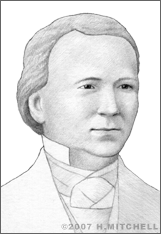Walter Hunt
Mechanic and independent inventor Walter Hunt secured a place in American history when he invented the useful, everyday device known as the safety pin in 1849.
Born on July 29, 1796, Hunt lived and worked in New York, where he invented a variety of tools and household items and made improvements to existing machinery. Among his most notable innovations were a fountain pen, a new type of rifle, a knife sharpener, artificial stone, a flax spinner, and an ice plough. In 1834, he built one of the world’s first eye-pointed-needle sewing machines. However, it is said that his daughter talked him out of commercializing the device by warning him that it would lead to massive unemployment among seamstresses.
More than a decade later, Hunt faced a situation in which he owed a man a $15 debt. He began working feverishly to think of a new creation that would earn him enough money to repay the sum. He began twisting a piece of metal wire until he had created a device he called the “dress pin,” with a spring at one end that forced the other end into place and a clasp that kept the pin’s point inside a protective case.
Hunt’s invention was not entirely novel; it was actually an improvement on a concept that the ancient Romans had used in jewelry, namely, fibulae, or brooches. His was not the first contemporary version of the safety pin either. A version appeared in 1842 that did not include the spring mechanism that Hunt designed. This feature, of course, exists in virtually all safety pins the world is accustomed to using today.
At the time, however, Hunt apparently thought little of his invention. He patented the safety pin on April 10, 1849 (U.S. Patent No. 6,281), and he willingly sold rights to it for just $400. Sales of the invention would later earn a number of opportunistic businessmen substantial fortunes, but Hunt never earned another penny for his creation. The safety pin has hundreds of uses, including fastening diapers and clothing such as trousers, shirts, and jackets, and even as a component of jewelry.
Meanwhile, Hunt engaged in an intellectual property struggle over the sewing machine after Elias Howe patented a similar machine in 1846. In the 1950s, when Isaac Merritt Singer began mass marketing eye-pointed-needle sewing machines, he brought a suit against Howe, who wished to be paid royalties for the machine. Singer attempted to fight Howe’s patent by showing that the technology was decades old, and it was revealed that Hunt had been the original creator of the type of system Howe had laid claim to. Hunt had abandoned the concept, however, without ever patenting it. Thus, in 1954, Howe’s patent was upheld.
Prolific Hunt, meanwhile, achieved moderate success but fell short of becoming a household name. He died on June 8, 1859 at the age of 63.


